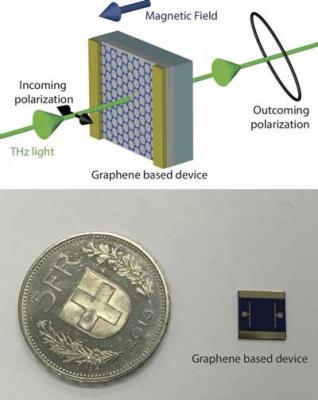Researchers from the University of Geneva, working with the Federal Polytechnic School in Zurich (ETHZ) and two Spanish research teams, have come up with a technique based on the use of graphene that allows for terahertz waves to be controlled accurately. This discovery paves the way for a practical use of terahertz waves, in particular for imaging and telecommunications.

Terahertz waves allow for the detection of materials that are undetectable at other frequencies, but the use of these waves is limited by the absence of suitable devices and materials allowing to control them. The team developed a technique in which graphene allows for the potentially very quick control of both the intensity and the polarization of terahertz light. "The interaction between terahertz radiation and the electrons in graphene is very strong and we have therefore come to the hypothesis that it should be possible to use graphene to manage terahertz waves," the team explains.
Working within the framework of the European project Graphene Flagship, scientists have made a graphene-based transistor adapted to terahertz waves. "By combining the electrical field, which enables us to control the number of electrons in graphene and thus allows more or less light to pass through, with the magnetic field, which bends the electronic orbits, we have been able to control not just the intensity of the terahertz waves, but also their polarization," comments a member of the UNIGE research team. "It is rare that purely electrical effects are used to control magnetic phenomena."
Today, the team's focus is to move on from the prototype, and develop practical applications and new opportunities by controlling terahertz waves. Their objective is to make terahertz waves industrially competitive in the next few years.
There are two main areas of application for this innovation, the first being communications. "Using a film of graphene associated with terahertz waves, we should be potentially able to send fully-secured information at speeds of about 10 to 100 times faster than with Wi-Fi or radio waves, and do it securely over short distances" explain the researchers.
The second line of applications is imaging. Being non-ionizing, terahertz waves do not alter DNA and therefore are very useful in medicine, biology and pharmacy. In addition, the control of the circular polarization of the terahertz waves will allow distinction between different symmetries (left-handed or right-handed) of biological molecules, which is a very important attribute in medical applications.
Furthermore, there is potentially a very significant application of these waves in homeland security. The researchers continue: "Terahertz waves are stopped by metals and are sensitive to plastics and organic matter. This could lead to more effective means of detecting firearms, drugs and explosives carried by individuals, and could perhaps serve as a tool to strengthen airport safety."

